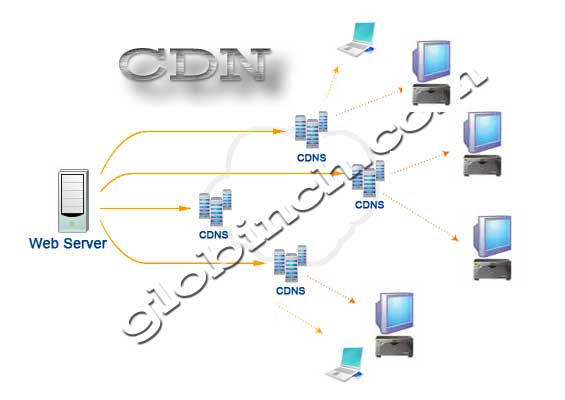CDN is a concept that many put into practice these days, but also leaves many confused as they do not quite follow how it’s supposed to help them, their website or their business endeavors. In reality, CDN is not hard at all to understand and it can easily make its value within a website’s setup be recognized.
So you want to know how CDN works before looking into any CDN price comparison. If that’s the case, it means that you are willing to put in the extra effort and make your website or domain top notch and a worthy challenger to all the other top websites available online. A lot of site managers are happy to just go through the regular process of creating a website and then limiting themselves to those results instead of pushing to introduce the various modern applications that make websites a hundred times more efficient for users. CDN is one of those modern applications and today’s article is all about CDN and how it works.
Content delivery networks are often called CDN and they serve the purpose of creating a bridge between the main server where all the contents of a website is stored and the various online users that access the website from everywhere in the world. CDN services take the website contents and host it on numerous servers in strategic positions across the globe. Once a user accesses the site, they trigger the CDN feature which grabs the requested information from the server that is nearest to the user in question. Then it delivers it to them in a very fast manner and thus accounts for one more user that didn’t have to wait a hellish amount of time for the website to load just because the main server was very far away from where they live. It’s a great way of boosting loading speeds for every single visitor of the site, and any web domain that aims to reach a high following, needs to implement CDN into their plan of operation.
Types of CDN
There are two main types of CDN. There is Push CDN, which is used for situations of limited circulation or low traffic, and there is Pull or Origin/Original CDN, which is preferred for high profile websites or websites that pull in a large number of visitors regularly. The two act differently and have distinct characteristics which make them better suited for the job depending on the characteristics of the hosted website.
Push CDN
Push CDN allows the owner or manager of a domain to manually or automatically upload select content from the main server up to the CDN server. From here, the content remains stationary and is only altered through updates, expiration dates and refreshes when said administrator sees fit.
Pull CDN
Pull CDN operates in a high contrast with Push CDN as in this scenario the CDN server pulls the information from the main server and doesn’t require the administrator to upload specific content. This content is later accessed and deployed to users based on the requests coming from browsers all across the globe, constantly updating the contents on the server.
The frustrations of CDN-less website efforts
Managing a website can at times be very difficult or frustrating because of the various issues that might surface. Of course, there are your regular, sometimes frequent problems such as having your website crash because of being exposed to a too big of a traffic rate or not having people visit it at all because of a competing website that offers similar content or services. It’s not easy to have a great website loved by the entire world which always delivers high quality content. But it’s going to be even harder without proper CDN implementation. There are quite a few issues that can and most certainly will arise. Here are some of the things non-CDN ready websites have to deal with:
Latency
It’s one of the biggest problems that equally affect website quality and user interest. Not all websites are dealing with this problem because latency is something that occurs only in specific cases where a website handles the kind of content which would imply it. Latency is represented by a delay between the server reaction and the request of the user internet browser. This can be especially frustrating since most content that risks being affected by latency is also the kind that people want to be snappy and not keep them waiting for both time efficiency and immersion reasons.
User restriction
This is another type of problem that you might have to deal with if you don’t implement CDN solutions. Basically, if there is no CDN service available, your website relies solely on the efficiency of the main server This won’t be a problem for those living in relatively close proximity to where the server is, but those far away or even on other continents will definitely be pushed out since the website won’t be as easy to access for them as it is for those close by. This can make it so your website will only be restricted to close proximity user access which dramatically limits its capability of reaching people.
It’s all very dependent on a number of variables though, and lack of CDN can be an inconvenience or a tragedy depending on a number of things such as the purpose, size, natural speed, execution type and content type of a website. These things alongside the position of the user trying to access the website can make lack of CDN more or less of a pain. But it is a pain nonetheless for some if they have gotten accustomed to the fast ways of CDN ready top websites which though them that they are only deserving of a certain speed and performance.
It’s all about pleasing the users
The main conclusion here, from a user point of view but also a website manager trying to understand and cater to the user, is that performance is key in order to succeed as a website. This brings us to the next point, which is the fact that not all CDN providers are able to provide performance and efficiency. Some just don’t specialize in what it is that you particularly need while others are just downright bad. That’s why it’s very important to research thoroughly when considering the offer of a CDN provider so that you are absolutely sure that it will be a positive move. In that regard, here are some things that you will want to pay attention to so that at the end of the day you will be pleased with your decision:
Response times
If you thought having poor response times before CDN can be bad, you should know that there is such a thing as bad response times with CDN enabled. Response times represent how much time is needed for the server, in this case the CDN server, to respond to the browser request of users trying to access the contents of a page on your website.
Connection times
How fast a server is able to establish connections can be critical to the efficiency of the entire setup. It would be highly ineffective to invest in CDN that can’t provide great connection times and allow you to focus on other issues.
Uptime
Make sure the CDN service you choose comes with permanent uptime. Having your website inactive will lose you business as such inconveniences generally make users abandon websites completely. Internet users are an interesting case, in the sense that they are quick to show their loyalty to a specific service or provider, but if things aren’t kept at a certain standard in terms of quality, they have no problems abandoning your website completely. In order to assure that this doesn’t happen, choose a CDN service with 24/7 uptime.
Expansion
The whole point of CDN is to expand your operation and make it viable in lands far away thus extending your website’s reach and popularity. If a CDN service doesn’t have a great network setup which provides servers all across the world, it’s best if you keep looking.
All these elements come together to form a good CDN service, so having one but lacking another is pretty much equivalent to not having any at all. A website that wants to successfully expand and prosper needs a CDN provider that excels in all these departments and provides a well oiled machine that can properly accommodate your website content.
There are many CDN providers out there and it’s simple to acquire the services of one. But making sure that choice won’t come back later to bite you is a little trickier and the time investment needed to make sure that’s not the case is well worth it. In conclusion, CDN has evolved into a must-have feature that is required for a website to be able to properly function and accommodate users worldwide. Not implementing CDN can easily results in having poor attendance on your website which in turn translates to a big loss of profit.
